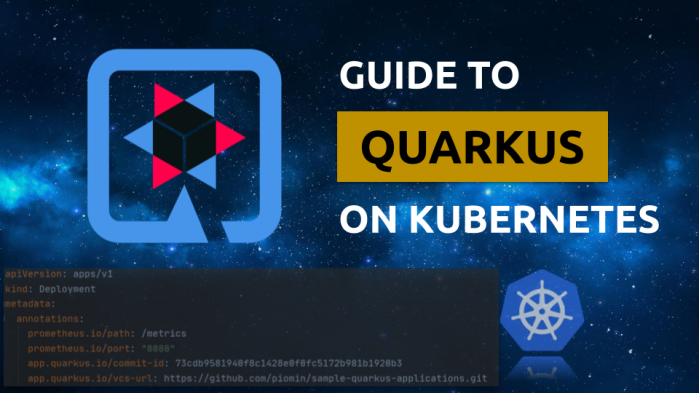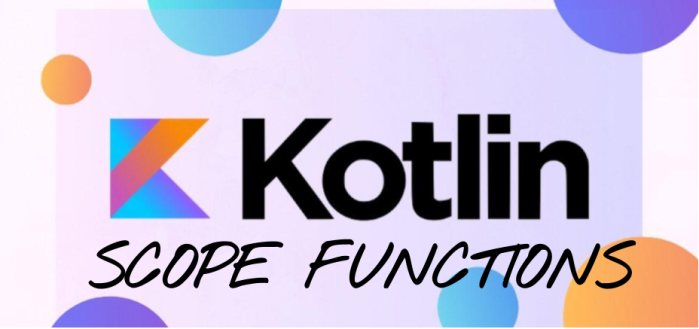Quarkus is usually described as a Kubernetes-native Java framework. It allows us to automatically generate Kubernetes resources based on the defaults and user-provided configuration. It also provides an extension for building and pushing container images. Quarkus can create a container image and push it to a registry before deploying the application to the target platform. It also provides an extension that allows developers to use Kubernetes ConfigMap as a configuration source, without having to mount them into the pod. We may use fabric8 Kubernetes Client directly to interact with the cluster, for example during JUnit tests. Continue reading “Guide to Quarkus on Kubernetes”
Tag: Kotlin
Guide to Quarkus with Kotlin
Quarkus is a lightweight Java framework developed by RedHat. It is dedicated for cloud-native applications that require a small memory footprint and a fast startup time. Its programming model is built on top of proven standards like Eclipse MicroProfile. Recently it is growing in popularity. It may be considered as an alternative to Spring Boot framework, especially if you are running your applications on Kubernetes or OpenShift. Continue reading “Guide to Quarkus with Kotlin”
Kotlin Coroutines vs Java Threads
There are probably many articles about Kotlin coroutines online. That’s why I would like to focus just on showing you the difference between concept over coroutines and threads – a well-known concurrency mechanism in Java. We will start from a small portion of theory. Continue reading “Kotlin Coroutines vs Java Threads”
Distributed Transactions in Microservices with Spring Boot
When I’m talking about microservices with other people they are often asking me about approach to distributed transactions. My advice is always the same – try to completely avoid distributed transactions in your microservices architecture. It is a very complex process with a lot of moving parts that can fail. That’s why it does not fit to the nature of microservices-based systems.
Continue reading “Distributed Transactions in Microservices with Spring Boot”
A Deep Dive Into Spring Cloud Load Balancer
Spring Cloud is currently on the verge of large changes. I have been writing about it in my previous article A New Era of Spring Cloud. While almost all of Spring Cloud Netflix components will be removed in the next release, it seems that the biggest change is a replacement of Ribbon client into Spring Cloud Load Balancer. Continue reading “A Deep Dive Into Spring Cloud Load Balancer”
Kotlin Scope Functions
Scope functions is one of the Kotlin feature I really like. When using such a function on an object, you are executing a block of code within the context of that object. You won’t find a similar feature in Java. There are five scope functions available in Kotlin: let, apply, run, with and also. In fact all of them is doing the same thing – execute a block of code on an object. However, there are some differences and we will discuss them on the simple example of code. Continue reading “Kotlin Scope Functions”
Running Kotlin Microservice on Google Kubernetes Engine
In this article I’ll guide you through the steps required for building and running simple Kotlin microservice on Google Kubernetes Engine. We will use such and framework like Spring Boot, Skaffold and Jib. Continue reading “Running Kotlin Microservice on Google Kubernetes Engine”
Kotlin Microservice with Spring Boot
You may find many examples of microservices built with Spring Boot on my blog, but the most of them is written in Java. With the rise in popularity of Kotlin language it is more often used with Spring Boot for building backend services. Starting with version 5 Spring Framework has introduced first-class support for Kotlin. In this article I’m going to show you example of microservice build with Kotlin and Spring Boot 2. I’ll describe some interesting features of Spring Boot, which can treated as a set of good practices when building backend, REST-based microservices. Continue reading “Kotlin Microservice with Spring Boot”
Reactive programming with Project Reactor
If you are building reactive microservices you would probably have to merge data streams from different source APIs into a single result stream. It inspired me to create this article containing some most common scenarios of using reactive streams in microservice-based architecture during inter-service communication. I have already described some aspects related to reactive programming with Spring based on Spring WebFlux and Spring Data JDBC projects in the following articles:
- Reactive Microservices with Spring WebFlux and Spring Cloud
- Introduction to Reactive APIs with Postgres, R2DBC, Spring Data JDBC and Spring WebFlux
Continue reading “Reactive programming with Project Reactor”
Kotlin Microservices with Ktor
Ktor is a framework for building asynchronous applications on the server and client side. It is fully written in Kotlin. The main goal of Ktor is to provide an end-to-end multiplatform application framework for connected applications. It allows to easily build web applications and HTTP services, so we can be use it for building microservices-based architecture. Let’s discuss the main features of Ktor framework by the example of a simple system consisting of two microservices. Continue reading “Kotlin Microservices with Ktor”
5 Things You Will Like in Kotlin as a Java Developer
Kotlin language is gaining more and more popularity recently. It is widely used no longer just in mobile apps development, but also for server-side systems. As you probably know is a statically typed programming language that runs on the JVM. That’s why it is often compared with Java language. One of the main reasons of Kotlin popularity is a simplicity. It cleans and removes a lot of the code bloat from Java. However, it is also very similar to Java, so that any experienced Java developer can pick up Kotlin in a few hours.
In this article I’m going to discuss some interesting Kotlin features used for server-side development in comparison to Java. Here’s my personal list of favourite Kotlin features unavailable for Java language.
1. Collections and Generics
I really like Java, but sometimes working with generic collections may be an unpleasant experience, especially if you have to use wildcard types. The good news are that Kotlin doesn’t have any wildcard types. Instead, it provides two other features called declaration-site variance and type projections. Now, let’s consider the following class hierarchy.
abstract class Vehicle {
}
class Truck extends Vehicle {
}
class PassengerCar extends Vehicle {
}
I defined a generic repository that contains all objects with a given type.
public class Repository<T> {
List<T> l = new ArrayList<>();
public void addAll(List<T> l) {
l.addAll(l);
}
public void add(T t) {
l.add(t);
}
}
Now, I would like to store all the vehicles in that repository, so I declare Repository r = new Repository<Vehicle>(). But invoking repository method addAll with List<Truck> as a parameter you will receive the following error.

You can change the declaration of addAll method to accept parameter that declared like that: public void addAll(List<? extends T> l), and it works fine..
Of course, this situation has a logical explanation. First, generic types in Java are invariant, what in fact means that List<Truck> is not a subtype of List<Vehicle>, although Truck is a subtype of Vehicle. The addAll method takes wildcard type argument <? extends T> as a parameter, what indicates that this method accepts a collection of objects of T or some subtype of T, not just T itself. The List<Truck> is a subtype of List<? extends Vehicle>, but the target list is still List<Vehicle>. I don’t want to get into details about this behaviour – you can read more about it in Java specification. The important thing for us is that Kotlin is solving this problem using feature called Declaration-site variance. If we add the out modifier to the MutableList parameter inside addAll method declaration the compiler will allow to add a list of Truck objects. The smart explanation of that process is provided on the Kotlin site: ‘In “clever words” they say that the class C is covariant in the parameter T, or that T is a covariant type parameter. You can think of C as being a producer of T’s, and NOT a consumer of T’s.’
class Repository<T> {
var l: MutableList<T> = ArrayList()
fun addAll(objects: MutableList<out T>) {
l.addAll(objects)
}
fun add(o: T) {
l.add(o)
}
}
fun main(args: Array<String>) {
val r = Repository<Vehicle>()
var l1: MutableList<Truck> = ArrayList()
l1.add(Truck())
r.addAll(l1)
println("${r.l.size}")
}
2. Data classes
You probably excellent know Java POJOs (Plain Old Java Object). If you are following Java good practices such a class should implement getters, setters, hashCode and equals methods, and also toString method for logging needs. Such an implementation may take up a lot of space even for simple class with only four fields – as shown below (methods auto-generated using Eclipse IDE).
public class Person {
private Integer id;
private String firstName;
private String lastName;
private int age;
public Person(Integer id, String firstName, String lastName) {
this.id = id;
this.firstName = firstName;
this.lastName = lastName;
}
public Integer getId() {
return id;
}
public void setId(Integer id) {
this.id = id;
}
public String getFirstName() {
return firstName;
}
public void setFirstName(String firstName) {
this.firstName = firstName;
}
public String getLastName() {
return lastName;
}
public void setLastName(String lastName) {
this.lastName = lastName;
}
public int getAge() {
return age;
}
public void setAge(int age) {
this.age = age;
}
@Override
public int hashCode() {
final int prime = 31;
int result = 1;
result = prime * result + ((firstName == null) ? 0 : firstName.hashCode());
result = prime * result + ((id == null) ? 0 : id.hashCode());
result = prime * result + ((lastName == null) ? 0 : lastName.hashCode());
return result;
}
@Override
public boolean equals(Object obj) {
if (this == obj)
return true;
if (obj == null)
return false;
if (getClass() != obj.getClass())
return false;
Person other = (Person) obj;
if (firstName == null) {
if (other.firstName != null)
return false;
} else if (!firstName.equals(other.firstName))
return false;
if (id == null) {
if (other.id != null)
return false;
} else if (!id.equals(other.id))
return false;
if (lastName == null) {
if (other.lastName != null)
return false;
} else if (!lastName.equals(other.lastName))
return false;
return true;
}
@Override
public String toString() {
return "Person [id=" + id + ", firstName=" + firstName + ", lastName=" + lastName + "]";
}
}
To avoid many additional lines of code inside your POJO classes you may use project Lombok. It provides a set of annotations that can be used on the class to deliver implementations of getters/setters, equals and hashCode methods. It is also possible to annotate your class with @Data, that bundles all the features of @ToString, @EqualsAndHashCode, @Getter / @Setter and @RequiredArgsConstructor together. So, with Lombok’s @Data the POJO is going to look like as shown below – assuming you don’t require a constructor with parameters.
@Data
public class Person {
private Integer id;
private String firstName;
private String lastName;
private int age;
}
Including and using Lombok with Java application is quite simple and supported by all the main developer IDEs, but Kotlin solves this issue out-of-the-box. It provides functionality called data classes, which is enabled after adding keyword data to the class definition. The compiler automatically derives the methods from all properties declared in the primary constructor:
equals()/hashCode()pairtoString()methodcomponentN()functions corresponding to the properties in their order of declarationcopy()function
Because Kotlin internally generates a default getter and setter for mutable properties (declared as var), and a getter for read-only properties (declared as val) the similar implementation of Person Java POJO in Kotlin will look as shown below.
data class Person(val firstName: String, val lastName: String, val id: Int) {
var age: Int = 0
}
What’s worth mentioning the compiler only uses the properties defined inside the primary constructor for the automatically generated functions. So, the field age, which is declared inside class body, will not be used by toString, equals, hashCode, and copy implementations.
3. Names for test methods
Now, let’s implement some test cases that proofs the features described in the step 2 works properly. The following three tests are comparing two objects with different values of age property, trying to add the same object to the Java HashSet twice, and checking if componentN method of data class is returning properties in the right order.
@Test fun `Test person equality excluding "age" property`() {
val person = Person("John", "Smith", 1)
person.age = 35
val person2 = Person("John", "Smith", 1)
person2.age = 45
Assert.assertEquals(person, person2)
}
@Test fun `Test person componentN method for properties`() {
val person = Person("John", "Smith", 1)
Assert.assertEquals("John", person.component1())
Assert.assertEquals("Smith", person.component2())
Assert.assertEquals(1, person.component3())
}
@Test fun `Test adding and getting person from a Set`() {
val s = HashSet<Person>()
val person = Person("John", "Smith", 1)
var added = s.add(person)
Assert.assertTrue(added)
added = s.add(person)
Assert.assertFalse(added)
}
As you see on the fragment of code above Kotlin is accepting to use method names with spaces enclosed in backticks. Thanks to that I can set a descriptive form of test name, which is then visible during execution, and you know exactly what’s going on 🙂

4. Extensions
Let’s consider the situation that we have a library contains class definitions, which cannot be changed, and we need to add there some methods. In Java, we have some choices to implement such an approach. We can just extend the existing class, implement there a new method or for example implement it with Decorator pattern.
Now, let’s assume we have the following Java class containing list of persons and exposing getters/setters.
public class Organization {
private List<Person> persons;
public List<Person> getPersons() {
return persons;
}
public void setPersons(List<Person> persons) {
this.persons = persons;
}
}
If I would like to have the method for adding single Person object to the list I would have to extends Organization, and implement new method there.
public class OrganizationExt extends Organization {
public void addPerson(Person person) {
getPersons().add(person);
}
}
Kotlin provides the ability to extend a class with a new functionality without having to inherit from the base class. This is done via special declarations called extensions. Here’s the similar declaration to Organization Java class in Kotlin. Because Kotlin treats simple Listclass as immutable, we need to define MutableList.
class Organization(val persons: MutableList<Person> = ArrayList()) {
}
We can easily extend it with addPerson method as shown below. Extensions are resolved statically, and they do not modify extended classes.
class OrganizationTest {
fun Organization.addPerson(person: Person) {
persons.add(person)
}
@Test
fun testExtension() {
val organization = Organization()
organization.addPerson(Person("John", "Smith", 1))
Assert.assertTrue(organization.persons.size == 1)
}
}
5. String templates
Here’s a little something to make you happy – not available in Java.
println("Organization ${organization.name} with ${organization.persons.size} persons")
Conclusion
Of course there are some other differences between Java and Kotlin. This is only my personal list of favourite features unavailable in Java. The sample source code with described samples is available on GitHub: sample-kotlin-playground.










